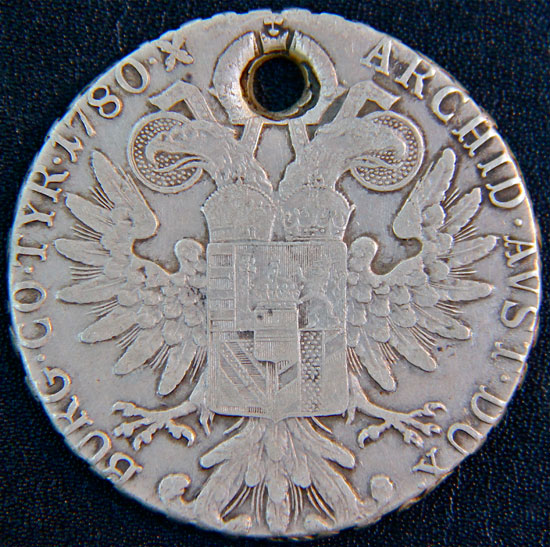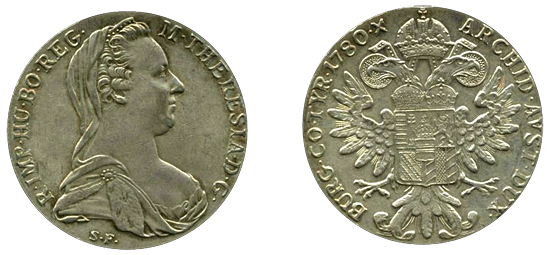The MTT
Today, the almighty Thaler. The Honors College at the University of Houston presents this program about the machines that make our civilization run, and the people whose ingenuity created them.
Recently I was clearing out my parents' apartment and found a cache of coins from their days in Nigeria. These were mostly huge British pennies, specially minted with a hole in the center so African traders could string them together. But two bright silver coins grabbed my attention. They were the size of silver dollars, faced with the portrait of a woman and backed with a double-headed eagle. Their date really shocked me: 1780.

My own MTT. Note the hole drilled for stringing. These coins were often used as jewelry as well as currency, a credit to Maria Theresa's attention to aesthetic design. Photograph by Richard Armstrong.
After some investigation, I found I was holding one of the most circulated currencies the world has ever known: the Maria Theresa Thaler. Maria Theresa ruled over the Habsburg Empire in the eighteenth century for forty years. Her matronly portrait graces the coin, along with her abbreviated Latin titles. The reverse depicts the double-headed eagle of the Holy Roman Empire.

Reverse side of my Thaler. Photograph by Richard Armstrong.
This coin was originally minted during her reign, and she demanded that it meet the highest standards for both silver content and aesthetic design. The name Thaler derives from the Joachimsthal, or Valley of St. Joachim, in Habsburg Bohemia. Rich silver deposits in that region supported the minting of high quality silver coins, known as Joachimsthaler, or thaler for short. That's where we get our word dollar.
Maria Theresa had her first thaler minted in 1741, and took great pains to secure its value. She signed one of the first international coinage conventions in 1753, which defined its silver content and set exchange rates. This ensured it would become a stable currency for international trade. In fact, it enjoyed a success she could hardly have imagined when she died in 1780. By then, the Habsburg mints had struck over 30 million thalers.
The thaler traveled from European ports to trade centers of the Middle East and Africa, where it became a standard for international exchange, particularly in areas that lacked coinage. The Empress's original coin was so loved and trusted that Arab traders wouldn't accept anything other than Maria Theresa's 1780 final edition. So the mints of Austria restruck the same coin year after year, always with the date 1780. Its inscribed edge meant it could not be shaved or clipped to glean bits of silver, unlike the Ottoman medjidiye. As the Ottoman Empire weakened, the thaler helped to secure trade, buy smuggled weapons, and bribe officials throughout the Middle East.
Thalers bought coffee and silk in Mocha and slaves in Zanzibar; they supplied British soldiers in Ethiopia, covered costs for Muslim pilgrims to Mecca, and paid ransoms and dowries from Morocco to Kano to Oman. In 1935, Mussolini demanded the dies from Austria to mint coins for his war in Abyssinia. He refused to share his thalers with Britain, so the British minted 14 million of their own Maria Theresa Thalers in London, and another 19 million in Bombay.
Most likely my thalers are from the British period. So while I don't really have coins from 1780, I do have a bit of stable currency on hand. You have to admit, this old lady really gets around.
I'm Richard Armstrong, at the University of Houston, where we're interested in the way inventive minds work.

A pristine Maria Theresa Thaler. A Wikipedia Commons photograph from author Carlomorino.
Sources:
1. Harrigan, Peter. 2003. 'Tales of a Thaler.' Saudi Aramco World. January/February 2003: 14-23. See online version.
2. Semple, Clare. 2007. A Silver Legend: The Story of the Maria Theresa Thaler. Barzan Publishing.
3. Tschoegl, Adrian. 2001. 'Maria Theresa's Thaler: A Case of International Money.' Eastern Economic Journal 27.4 (2001): 443-462.
4. http://www.theresia.name/en/ (A very comprehensive website dedicated to the thaler, with numerous images.)
This episode was first aired on June 6, 2012